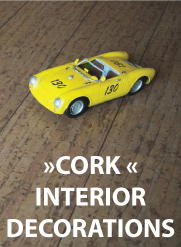In our online space you can visualize and adquire some products processed through the cork, that for example Bags, Accessories, several Jewelries, articles of Decoration and of Office.
Our products are produced exclusively in the European Community.
Design Textinova is an exclusive mark of TEXTINOVA, a company that needs to demonstrate and to market several products transformed through the Cork, always prevailing values as elegance, versatility and respect for nature, such as the material demands it.
The Cork is a vegetable matter from the bark of cork oak - Quercus Suber L. .
The cork oak Quercus suber grows in large parts of the Mediterranean, Spain, France, Italy, Morocco, Tunisia and especially in Portugal, where there are over 189 000 hectares of forest areas with oak trees.
This noble tree has special characteristics, for example it can live on average 150 to 200 years, despite many harvests that man makes throughout its existence, about 16 harvests over a period in a period of 9 in 9 years.
Its bark is extracted, that have a fiber with origin versatile vegetable that can be used and transformed for various objects.
Its bark is extracted, that have a fiber with origin versatile vegetable that can be used and transformed for various objects.
This material vegetable which is harvested with as much care has unique qualities and unsurpassed to this day no other material
could emulate or surpass.
The Cork is by excellence a lightweight material, resistant to liquids and gases, and is a great acoustic and thermal insulator. Above all, it is a material 100% natural, recyclable and biode-gradable, are some of the essential aspects in a society like ours we live in - Less Pollution and more Environmental friendly.
The first uses of Cork by Man ascend to ancient times.
There were several civilizations that have used this material of plant origin, such as the Egyptians who used the cork to pitchers containing wine.
In ancient Greece it was used for the manufacture of sandals for-floating buoys for fishing nets and the Egyptians used the cork to pitchers containing wine and oil.
The Portuguese used this material for the construction of the ships in the Age of Discovery "new worlds" because it was a tough material and not rotted.
In the seventeenth century our modern civilizations have rediscovered the usefulness of the cork, serving as a stopper for bottles of wine and champagne. Over the years, man has explored the cork in order to transform it into simple objects of decoration, accessories, footwear components, and others.
The use of the Web site requires agreement on terms and conditions of sale. Development and Design: www.brunabernardino.com



